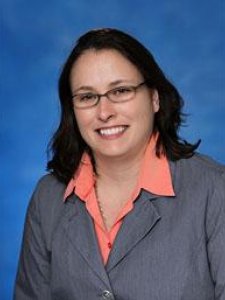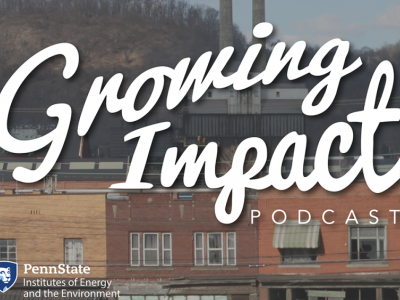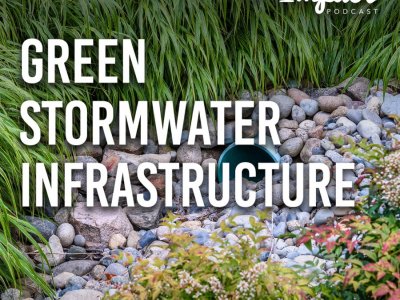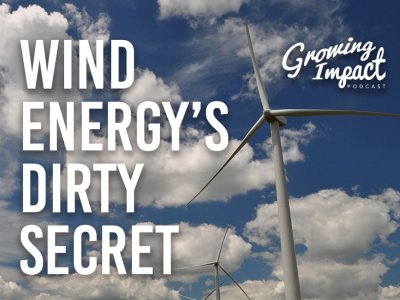Melissa Bopp and her colleagues examine the role of the built and natural environments and their influence on physical activity, healthy eating, and air quality in the Mon Valley, an area that has seen steady economic decline since the departure of the steel industry in the late 20th century.
Transcript
INTRO: We see higher rates of things like heart disease, obesity, diabetes, certain forms of cancer. In this area, asthma and other respiratory diseases tend to be fairly high as well in underserved communities.
HOST: Welcome to Growing Impact, a podcast by the Institute of Energy and the environment at Penn State. Growing Impact explores cutting-edge projects of researchers and scientists who are solving some of the world's most challenging energy and environmental issues. Each project has been funded through an innovative seed grant program that is facilitated through IEE. I'm your host, Kevin Sliman. On this episode of Growing Impact, I speak with Melissa Bopp, an associate professor of kinesiology, whose research looks to understand and promote physical activity in diverse populations and settings. We discuss her seed grant project titled “Engaging Underserved Communities in Environmental Assessment for Healthy Living,” through which she and her colleagues investigate underserved and racially diverse neighborhoods in the Pittsburgh area, specifically the Mon Valley. This is to examine the role of the built and natural environments in influencing physical activity, healthy eating, and air quality.
HOST: Melissa, welcome to Growing Impact.
Melissa Bopp (MB): Thank you for having me. I'm delighted to be here on behalf of myself and my colleagues to discuss our project.
HOST: Can you provide a summary of your project and give us a flavor of what it is that you're working on?
MB: Sure, absolutely. Our kind of very basic description of our project is that we are looking to understand the role of the built and natural environment on health outcomes, health behaviors in underserved communities in Allegheny County.
HOST: Just for folks who don't know, so could you tell us a little bit of Allegheny County? So that's Pittsburgh, Pennsylvania, right? That's the main city there. Is there a way we could describe or talk about the communities that you're focused on?
MB: The Mon Valley sitting right along the Monongahela River. It's a very rugged landscape. So the river kind of winds through the area. Very steep hills, steep cliffs and things like that. A lot of small communities that in the 1800s were kind of driving the industrial revolution here in the United States with big steel plants and things like that. And the communities built up around those steel plants and other industrial centers and things like that. And then as things changed throughout the 20th century and economic situations changed and there was a lot of closure or downsizing a plant activity and things like that. The communities changed and evolved with that and some of the residual effects that had resulted in difficult economic situations for some of these communities. And then also difficult environments for being healthy, for the residents of the communities to be healthy, and from a variety of different ways and influences. Air and water quality, opportunities to engage in healthy behaviors and things like that have all been moderately challenging in a lot of these areas. As much as we're studying this particular area, we're hoping that we can maybe shed some light on some things that could be generalizable to other Rust Belt communities that have experienced similar kinds of things to help them with the same kinds of struggles that we're trying to understand as well.
HOST: What are environmental assessments and what are you looking for in those assessments?
MB: That's one of the things that we're aiming to do with this project is to conduct environmental assessments throughout the different communities in the Mon Valley to get an understanding of what are the strengths of the community in terms of resources available for promoting healthy living? And then what are some areas that could be improved upon? And we’d like to use both objective and subjective assessments in our approach. We are using for objective assessments. we're doing some GIS analysis, we are doing some mapping to understand where physical resources are located. For example, we're, we're building some asset maps for physical activity across these different communities. So we're documenting where are things like parks, trails, playgrounds, even recreational fitness facilities, private fitness facilities, places where people could go to be regularly active. Then we're also conducting subjective assessments because we understand that sometimes it doesn't matter what is physically there, but it's a matter of what people perceive there to be. An example of that is sidewalk quality, right? So if we would like to say, Hey, you know, go, I'll go for a walk. And, you know, in your community, we know you have good continuous sidewalks right there, three or four feet wide. We can tell by audit that we would go out and take a look and say, sidewalks in your neighborhood are pretty good. However, you perceive the sidewalks in your neighborhood to be dangerous, cracked, discontinuous so that you really don't feel like you could safely go for a walk, you're less likely to use that. So as much as it's important to document physically what is there, it’s important for us to understand what the residents of the communities themselves perceive about their neighborhoods.
HOST: For your project, could you define what underserved communities aren't?
MB: When we talk about underserved communities, we're going with the idea of health equity, and we're centered on equity as defined by the Centers for Disease Control and Prevention. So we think about race, ethnicity, income, education, even urban/rural status. And Allegheny County itself is a fairly urban county if you look collectively at the whole county. But some of the communities that we're dealing with are a little bit more small-town type of thing, and we are concerned about the disproportionate burden of preventable disease, disability, and death. So we know that we see higher rates of things like heart disease, obesity, diabetes, certain forms of cancer. In this area, asthma and other respiratory diseases tend to be fairly high as well in underserved communities.
HOST: Why is it so important to perform these kinds of assessments for underserved communities?
MB: For many communities being able to document your assets as well as being able to document maybe where you need to improve upon, is the first step in being able to advocate for change. So going to a city council meeting or a county commissioner’s meeting or things like that and saying, we need more parks and trails in our community. Okay. Well, tell me what you have. Well, I don't know what we have, but just feel like we don't have a lot of access. You know, you're not going to get very far with that. But if you can present information to decision-makers, to legislators, lawmakers about tying a lack of resources to disproportionately higher rate of disease, disability, and death, that should make it more compelling argument
HOST: What kind of health benefits come from this kind of assessment?
MB: It's well documented that there are many lifestyle-related diseases out there. So things that stem from poor health behaviors or physical inactivity, poor dietary choices, things like smoking, things that we know that are preventable. So heart disease, which is a leading cause of death in the United States, obesity and diabetes, which are closely tied to heart disease as well as many other chronic health outcomes and things like that. So when you think about trying to move the needle on major health outcomes, you need to start with what are some of the things that influences health outcomes in physical activity, participation and healthy eating are some of those particular factors. So, you know, we hope, you know, obviously this is very long-term outcome— it's not something that we would our project could solve for next year type of thing. This is a 5 to 10-year, maybe we see some small changes type of thing. But the first marker that we would expect to see is a greater awareness of health issues and health behaviors and how the environment can be tied to that. After that maybe comes improvements in those things in the resources, in the environment that makes it easier for people to be more active and to make healthier food choices. And then down the road from that would maybe see a change in those preventable, lifestyle-related diseases.
HOST: Could you discuss how a team of folks from different disciplines are able to add to this project?
MB: Yeah, I think I think a multidimensional problem calls for a multidisciplinary team is probably the best way to put that. So there are lot of factors when you start to look at community level health and health outcomes in the environment that just go beyond any one person's level of expertise. So I'm here in kinesiology, and I know a lot about health and I know a lot about health outcomes and how they tie to disease status. And we can talk about physiologic changes from participating in physical activity and things like that. And I know a little bit about and environment and what the evidence says, but I have a collaborator, Mallika Bose in landscape architecture, who has a background and urban planning and design. And she understands how communities are laid out and how that can drive human health, human behavior. And then we have Louisa Holmes in geography who also has this tremendous understanding of how to assess the environment and to document things using GIS mapping and how we can get it, both the perceived in the actual elements of our, our end goal of assessing the environment. We hope to be able to expand our team once we've gained a greater understanding of the scope of issues facing some of these communities. Perhaps there's additional people that we need to bring on. So I look forward to expanding our team in the future and seeing where this goes. So it's always valuable to sit at a table with people who come at issues from very different angles. I think we maximize our creativity and are much more efficient in how we can attack a problem.
HOST: What do you hope your project?
MB: As with any community-based participatory projects, the first thing that we would like to do is to build relationships throughout the community with different organizations and different stakeholders and partners to gain an understanding of the needs and concerns in and where we can possibly contribute. We have a lot of expertise related to physical activity, healthy eating, and health outcomes. And we want to be sure that we match our expertise to what the concerns are of the community and how maybe that ties to existing initiatives that are going on. I know there's a lot of work being done right now centered on air quality and a lot of negative respiratory health issues that are happening in the area. And we know that there are a lot of other health conditions that are tied to some of those things. That's an example of where we can see where we can contribute to existing projects that are going on.
HOST: What are the next steps and/or future plans when it come to this project? Anything you can discuss or talk about?
MB: We're in the process right now of learning and discovering a little bit more about our communities and learning about key stakeholders in important organizations that will be important for us to reach out to you and learn about and get to know in the future. And in the spring semester we're looking forward to connecting some of our field work and on-the-ground data collection, which will hopefully lead to some of the outcomes in me it outlined in our proposal tied to advocacy training and things like that. But I think the most important next steps we really can't predict right now, because I think it really depends on what we learn. I don't want to hypothesize right now on what the communities are going to say in terms of what their needs are. I think that it would be best for us to learn and then to see next steps in where we can be resource.
HOST: Thank you, Melissa, for spending time with us on growing impact and discussing your project with us.
MB: Thank you for having me. It's been a pleasure to speak about the context.
HOST: You've been listening to Growing Impact, a podcast by the Institute of Energy and the Environment at Penn State. I've been new host, Kevin Sliman. This has been season two, episode 8. Thank you for listening










